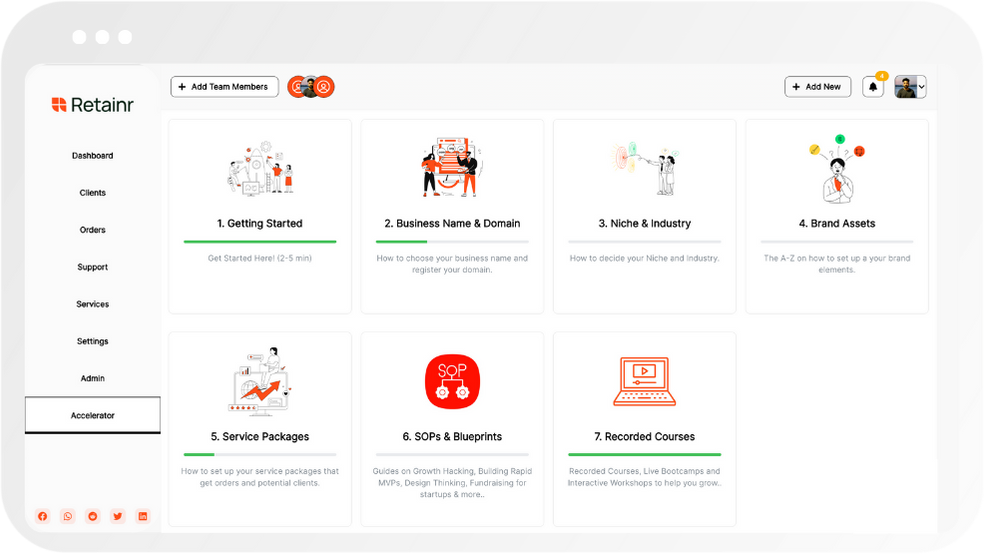
4 Effective Strategies for Niche Market Identification
Build with Retainr
Sell your products and services, manage clients, orders, payments, automate your client onboarding and management with your own branded web application.
Get Started1. What are the four effective strategies for niche market identification?
Understanding your Customers and their Needs
Firstly, the basis of identifying a suitable niche market is to understand your customers and their unique needs. In-depth market research is key in this process:
- Surveying potential customers on their needs and preferences.
- Keeping an eye on trends in customer reviews and feedback on related products or services.
- Conducting keyword research to understand what people are searching for in your industry.
- Analyzing competitors' customer base and identifying any underserved customer segments.
Choosing a Niche Where You Can Add Value
Secondly, it's advisable to select a niche where your business can add unique value. This is achieved by:
- Identifying spaces with a low level of competition.
- Highlighting your business’ unique strengths or selling points.
- Considering whether you can improve upon existing products or services.
Testing Your Niche Market Idea and Adjusting
Lastly, after identifying a potential niche market, it's critical to test your idea quickly and efficiently, and adjust based on the feedback received. The testing phase can be accomplished through:
| Steps | Description |
|---|---|
| Launching a Minimum Viable Product (MVP) | Offer a basic version of the product or service to early adopters and collect feedback. |
| Analyzing Feedback | Respond to customer feedback and make needed improvements to your product or service. |
| Iterating | Repeatedly go through the feedback-analyze-adjust cycle until product-market fit is attained. |
2. Can you provide examples of successful usage of these four niche market identification strategies?
Examples of Effective Niche Market Identification Strategies
Several successful companies have used the four niche market identification strategies that we've been discussing. These strategies can be used by businesses of all sizes, from startups to multinational corporations. Let's take a look at a few examples to illustrate.
1. Using Keyword Research
Amazon, the multinational technology company, is one such entity that has mastered the art of keyword research. They use it as one of their primary tools to identify potential markets for expansion. By analyzing what customers are searching for, they're able to introduce new products or enter new niche markets that align with consumer demands.
2. Surveying Customers
Starbucks is known for their dedication towards understanding the needs and preferences of their customers. Through surveys and customer feedback, they've been able to identify new product niches, such as plant-based milk alternatives and healthier food options, that appeal to their customers.
3. Monitoring Trends and Social Media Conversations
Apple, a company at the forefront of technology and lifestyle products, tracks trends and social media conversations to identify new markets. This strategy led to the development of the Apple watch, which caters to fitness and health-conscious consumers, a niche they identified through trend monitoring.
4. Competitor Analysis
Tesla didn’t invent electric cars, but they identified a niche that was overlooked by their competitors. Through careful competitor analysis, they found a potential for luxury electric cars. Today, Tesla dominates this niche market.
| Company | Niche Market Identification Strategy | Area Adressed |
|---|---|---|
| Amazon | Keyword Research | Product Expansion |
| Starbucks | Surveying Customers | Healthier Food Options |
| Apple | Monitoring Trends and Social Media Conversations | Health-conscious Consumers |
| Tesla | Competitor Analysis | Luxury Electric Cars |
In conclusion, these successful companies showcase the effective utilization of niche market identification strategies, affirming the feasibility and potency of these methods.
3. How does analyzing customer needs help in identifying a niche market?
Understanding Customer Needs for Market Identification
The comprehension of customer needs is pivotal in niche market identification. By focusing on the unique needs of customers, a business can pinpoint specific market segments that are under-served, thus identifying prospective niche markets. Businesses must employ various methods to understand customer needs accurately.
- Customer Surveys: These provide first-hand information on what customers look for in a product or service. This feedback aids in understanding their pain points that current offerings in the market cannot meet.
- Focus Groups: Engaging a diverse group of potential customers for discussion can shed light on specific interests, tastes, or preferences unmet by current market offerings.
- Online Analytics: Robust online analytic tools can help analyze customer behavior, preferences, and patterns, creating a myriad of opportunities for niche market identification.
Analysing Customer Needs: A Deep Dive
The analysis of customer needs is more than just skimming the surface. It requires a holistic understanding of customers, making it a complex process. To simplify this process, businesses can employ a structured approach.
| Steps | Description |
|---|---|
| Segmentation: | Divide your target market based on common characteristics such as demographics, psychographics, behavior, etc. |
| Identify Needs: | Upon segmentation, determine the unique needs of each segment. |
| Compare With Existing Offerings: | Evaluate if the identified needs are currently being met by the market offerings. |
Why is this analysis critical in Identifying Niche Markets?
Conducting a comprehensive analysis of customer needs is instrumental in identifying a profitable niche. This process uncovers potential market gaps that can be filled, thus providing a competitive advantage. It becomes possible to tailor your product or service to align with those specific needs, thereby capturing a niche market and establishing market dominance therein. From this perspective, the key to successful niche market identification lies in the depth of your understanding of customer needs.
4. Is competitor analysis essential in the process of niche market identification?
Importance of Competitor Analysis in Niche Market Identification
Competitor Analysis is an essential strategy used in the identification of niche markets. The presence, or lack thereof, of competitors in a potential niche market can be a significant determinant of whether it's a profitable and viable avenue for business growth. Competitor analysis can offer valuable insight into market saturation, market trends, and potential market gaps that your business could aim to fill.
Benefits of Competitor Analysis
- Market Saturation: By analyzing competitors, you can gauge the level of market saturation. If a niche market has too many players offering similar products or services, it might be oversaturated which can be a barrier to entry for your business.
- Market Trends: From competitor activity, you can detect current market trends. Being aware of what products or services are popular can help shape your business approach for your niche market.
- Market Gaps: Identifying what your competitors are not offering gives you a chance to fill those gaps. These opportunities can lead you to a profitable niche market.
Competitor Analysis Table
| Competitor | Products/Services | Strengths | Weaknesses |
|---|---|---|---|
| Competitor 1 | List their products/services | Identify their strengths | Spot their weaknesses |
| Competitor 2 | List their products/services | Identify their strengths | Spot their weaknesses |
| Competitor 3 | List their products/services | Identify their strengths | Spot their weaknesses |
The above competitor analysis table is a simple way to compare and contrast your potential competitors in a niche market. This kind of organized research helps when brainstorming a unique value proposition that can outshine your competitors.
5. Can you explain the keyword research strategy for niche market identification?
Keyword Research Strategy for Niche Market Identification
Keyword research is a pivotal strategy for identifying your niche market. It refers to identifying words or phrases relevant to your product or service that consumers use when searching online. Here are three steps you can follow to effectively utilize keyword research for niche market identification.
- Brainstorming: The first step to effective keyword research is brainstorming. Write down all ideas and phrases that come to mind when you think about your product or service. You can also survey your existing customers or peers to see which terms they would use to find your offering. This will give you a base list of potential keywords.
- Keyword Tools: SEO tools such as Google's Keyword Planner or SEMRush can be invaluable for expanding your base list. These tools provide information on search volumes, competition levels, and associated keywords, which can help you detect potentially profitable niche areas.
- Competitor Analysis: Finally, investigate your competitors. Analyze the keywords they are targeting in their online content and advertising. This will give you a sense of the phrases you may want to target or avoid.
A combination of these strategies will allow you to refine your keywords and hone in on your niche market. The following table illustrates these three steps.
| Step | Strategy Description |
|---|---|
| 1. Brainstorming | Write down ideas, phrases that come to mind when you think about your product or service. Survey your existing customers to get a base list of potential keywords. |
| 2. Keyword Tools | Use SEO tools like Google's Keyword Planner or SEMRush to expand your base list. These tools provide info on search volumes, competition levels, and associated keywords. |
| 3. Competitor Analysis | Analyze the keywords your competitors are targeting in their online content and advertising. This information can support your decision to target or avoid certain keywords. |
6. How can I conduct demographic and psychographic profiling for niche market identification?
Demographic Profiling for Niche Market Identification
Demographic profiling involves understanding the statistical characteristics of your potential customers. This includes age, sex, income level, ethnicity, occupation, and education. This type of profiling can provide valuable insights into who makes up a potential niche market prompting you to tailor your marketing strategies accordingly. Here's how to conduct demographic profiling:
- Market Research: You can use surveys, focus groups, interviews, and other techniques to gather demographic data about potential customers.
- Use Existing Customer Data: If you already have customers, you can use data from your sales records to identify demographic patterns.
- Online Analytics: Online platforms such as Google Analytics can provide detailed demographic data about the people who visit your website or interact with your online content.
- Public Records: You can also access demographic data in publicly available databases, such as census data.
Psychographic Profiling for Niche Market Identification
Psychographic profiling, on the other hand, deals with the lifestyle, values, attitudes, and personality traits of consumers. It can be as crucial as demographic profiling when identifying niche markets. Following are some strategies to conduct psychographic profiling:
- Surveys and Questionnaires: Ask questions that probe into lifestyles, attitudes, and behaviors to understand your customer's psychographics better.
- Social Media Analysis: Consumers often reveal a lot about their attitudes and preferences on social media. Tools like social listening can help you gather this data.
- Customer Reviews: Reviews can provide insights into what your customers value and their attitudes towards your products or services.
- Demographics: Information like age, gender, location, income level can provide invaluable insights. A business could discover for example that the product is popular among mid-age women in urban locations with a certain income level. That's a niche right there.
- Behavioral Data: This includes information on how customers use the product/service, how often do they use or buy it, what problems are they trying to solve with it. Using this data, a company can identify unusual or specific behaviors that indicate a niche market.
- Preferences: By observing what features or aspects of the product/service customers appreciate most, a company can pinpoint niches that particularly want these specific attributes.
- Tech-driven Trends: Emergence of new technologies often create niche markets. Take advantage of advancements like artificial intelligence, virtual reality, blockchain, etc., aligning your product to these trends.
- Lifestyle Trends: Changes in lifestyle, like healthy living, environmental consciousness, create new niche markets with unique consumer needs.
- Market Shifts: Fluctuations in economical, political, or social climates can create or reshape niches.
- Flexibility: Be prepared for dramatic changes that may shift your business niche.
- Continuous Learning: Adapt to new information and situations. Stay informed to maneuver any changes in your niche market.
- Evolving Strategy: Don't stick with an outdated business model. Consider current market trends as vital information for steering your niche identification.
- Maintain competition: Because niche markets are concentrated and specialized, the level of competition is relatively low. Therefore, your business doesn't have to fight tooth and nail with large corporations for market share. Instead, you can focus your resources on meeting the specific needs of your target market.
- Increase Profit Margins: Due to their specialized nature, products or services tailored to niche markets often command higher prices. Therefore, your business can enjoy increased profit margins.
- Establish Brand Loyalty: Niche markets are typically made of enthusiastic, passionate consumers. Once you manage to meet their specific needs consistently, they become loyal to your brand and can even advocate for your business, leading to favourable word-of-mouth marketing.
- Resource Optimization: Niche marketing enables your business to concentrate its resources on targeting a specific, manageable market segment. Your business can leverage this for more personalized, effective marketing and customer service, thus increasing customer satisfaction and retention.
- Limited Data: Due to the specificity of niche markets, it might be difficult to find a reasonable volume of potential customers to analyze their needs and preferences. This could potentially limit your data sources and the accuracy of your research.
- High Competition: Despite the advantages a niche market provides, competition can still be high. Many businesses may interpret the lower competition in niche markets as an easy opportunity, thus increasing the competition.
- Reduced Growth Potential: Because niche markets cater to a specific audience, there's a ceiling on the number of customers you can reach, effectively limiting your growth potential.
- Customer Dependence: Your business might become highly dependent on a small customer group that can leave you vulnerable to shifts in market conditions and customer behaviours.
Demographic & Psychographic Profiling Table Example
The table below is an example of how you can record your data when conducting demographic and psychographic profiling of your niche market:
| Demographic Data | Psychographic Data | |
|---|---|---|
| Example Customer | Female, 30-35, Professional, $50k-60k income, Masters Degree | Environmentally conscious, prefers online shopping, values high-quality products |
7. How is analyzing existing customers effective in identifying a niche market?
Analyzing Existing Customers
Understanding your existing customers' characteristics is one of the effective strategies in identifying a niche market. This approach includes analyzing their demographic data, their likes and dislikes, their purchasing behavior, among others. With this information, businesses can profile and segment their consumers which could lead towards the discovery of a potential niche market.
The Table Approach
Organizing this data into a table can give a more visual and structured output that aids the recognition of patterns and correlations. Below is a simple example of how this table can look like.
| Demographics | Behavior | Preferences |
|---|---|---|
| Mid-age women in urban areas | Use the product three times a week | Prefers organic ingredients |
| Students in college | Use the product during exam seasons | Prefers affordable pricing |
Converting Data into Actionable Insights
Having all the relevant data isn't enough. It has to be analyzed and interpreted properly to generate actionable insights. Drawing conclusions from the table above, there's a potential niche market of mid-age women in urban locations who prefer organic ingredients. Another is college students using the product during exam seasons, indicating a stress-related use. Businesses can then take these insights and develop targeted products, marketing campaigns or service adjustments to better cater to these niche markets.
8. What role does market trends play in identifying a niche market?
Understanding Market Trends
Market trends play a pivotal role in identifying a niche market. Trends are indicative of broad shifts in consumer behavior, preferences or societal movements. When there is a significant change in the marketplace, new niche markets may emerge. Savvy entrepreneurs identify these trends and carve out niches by offering specialized products or services to cater to these consumers.
How to Leverage Market Trends
By understanding how to leverage market trends in your niche identification process, you can position your business for success. Here are some strategies:
| Strategy | Description |
|---|---|
| Stay Informed | Keep up with industry news, consumer behaviors, and technological advancements. You never know when a new trend could lead to a promising niche market. |
| Understand Your Target Audience | Grasp the specifics of your potential customers. Your understanding of their needs, behavior, and preferences can direct you towards emerging trends. |
| Spot Opportunities | Look for areas where current consumer needs are not being met or where new needs could arise. These gaps often form the basis of successful niche markets. |
Embrace Change and Evolution
Market trends are not static. They are constantly evolving, and so should your approach in identifying niche markets. Customers’ tastes and preferences change, new technologies emerge, and political and economic shifts can impact market dynamics. Therefore, your business must be flexible and prepared to adapt accordingly:
9. How can these strategies for niche market identification help my business grow?
Understanding and Capitalizing on Niche Markets
Implementing effective strategies for niche market identification can significantly impact your business growth in numerous ways. The particularity of niche markets is that they have specific needs and preferences that are not met by mainstream providers. Therefore, when you identify and cater to these needs, you put your business in a position to attract and retain a loyal customer base.
The Observed Impact on Growth Parameters
The following table presents some of the key business growth parameters and how correctly identifying and exploiting a niche market can positively affect them:
| Growth Parameter | Benefit from Niche Marketing |
|---|---|
| Sales | Increased due to targeted marketing strategies and less competition. |
| Profit Margin | Higher due to the ability to charge premium prices for specialized products/services. |
| Customer Retention | Improved due to better customer satisfaction and establishment of brand loyalty. |
| Brand Reputation | Enhanced through exclusive provision of niche needs and positive word-of-mouth marketing. |
| Market Share | Expanded because of low competition within the niche market. |
10. What challenges might I face while implementing these strategies for niche market identification, and how can I overcome them?
Challenges and Solutions in Niche Market Identification
Implementing strategies for niche market identification can sometimes present challenges. But being aware of these potential roadblocks can help you tackle them effectively. Here are some of the challenges:
Overcoming Challenges in Niche Market Identification
Here are several approaches to overcome these challenges:
| Challenge | Solution |
|---|---|
| Limited Data | Use professional industry reports, market research agencies, surveys, and social media to gain insights. |
| High Competition | Strive for creating unique selling propositions (USPs), focus on providing exceptional customer service, and differentiate your brand. |
| Reduced Growth Potential | Establish multiple streams of income, diversify product or service offerings, or explore related niches, all while staying true to your initial market. |
| Customer Dependence | Build strong relationships with your customer base, encourage customer loyalty, and continuously evolve your products or services to keep up with their changing preferences. |
In Conclusion
Despite the obstacles, successfully identifying and operating within a niche market can provide your business with solace from some competition, more loyal customers, and opportunities to become a recognized expert within your field. Understanding these challenges and implementing strategies to overcome them can lead to business sustainability and success.
Conclusion
Understanding Niche Market Identification
Identifying a niche market is crucial for any business strategy as it allows a brand to focus on a segment of the market that may be overlooked or untapped by competitors. Having a well-defined target audience can enhance marketing efforts and product development, ensuring more return on investment (ROI). Here are four effective strategies for niche market identification.
Personal Passion and Knowledge
Starting a venture in an area where you have passion and knowledge can help you identify a niche market. Being an industry enthusiast, you would understand the needs and wants of a specific demographic, providing a rich source for product or service innovation.
Market Research and Analysis
Thorough market research and analysis is another strategy to identify niche markets. Certain tools and analytical platforms can provide insights into market trends, customer behavior patterns and industry reports, thus enabling a well-founded decision making towards your unique offering.
Identify Customer Problems and Needs
One way to identify a niche market is through identifying your potential customers' unmet needs or problems. This strategy tailors your product or service to solve those issues or meet those needs, thereby creating a unique proposition for a niche segment of the market.
Leveraging Technological Advances
Modern technology has opened up countless niches based on new needs and problems. Brands can identify these emerging markets through advancements in technology and innovate their product offering accordingly.
Considering the aforementioned strategies, it’s crucial to have a robust software solution to manage your affairs effectively in any niche market. Retainr.io is a comprehensive white-label software that helps businesses in selling, managing clients, orders, and payments with their own branded app. By adopting Retainr.io, businesses can centralize and streamline their operations to serve their niche markets more efficiently.
Boost Your Agency Growth
with Retainr Accelerator
Uncover secrets, strategies, and exclusive blueprints to take your agency's growth to the next level — from marketing insights to effective presentations and leveraging technology.

SOPs, Cheatsheets & Blueprints
Leverage 50+ SOPs (valued over $10K) offering practical guides, scripts, tools, hacks, templates, and cheat sheets to fast-track your startup's growth.
Connect with fellow entrepreneurs, share experiences, and get expert insights within our exclusive Facebook community.
.jpg)

Join a thriving community of growth hackers. Network, collaborate, and learn from like-minded entrepreneurs on a lifelong journey to success.

Gain expertise with recorded Courses, Live Bootcamps and interactive Workshops on topics like growth hacking, copywriting, no-code funnel building, performance marketing and more, taught by seasoned coaches & industry experts.

.jpg)

.jpeg)


